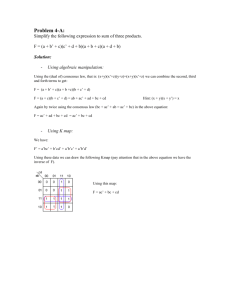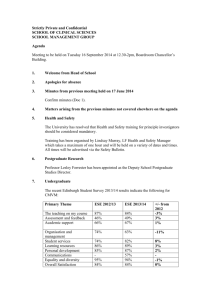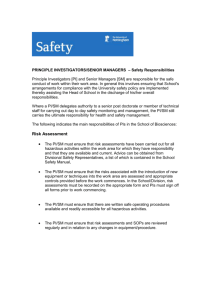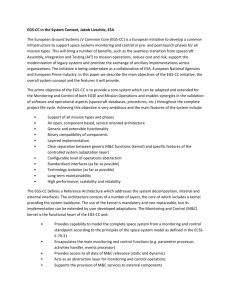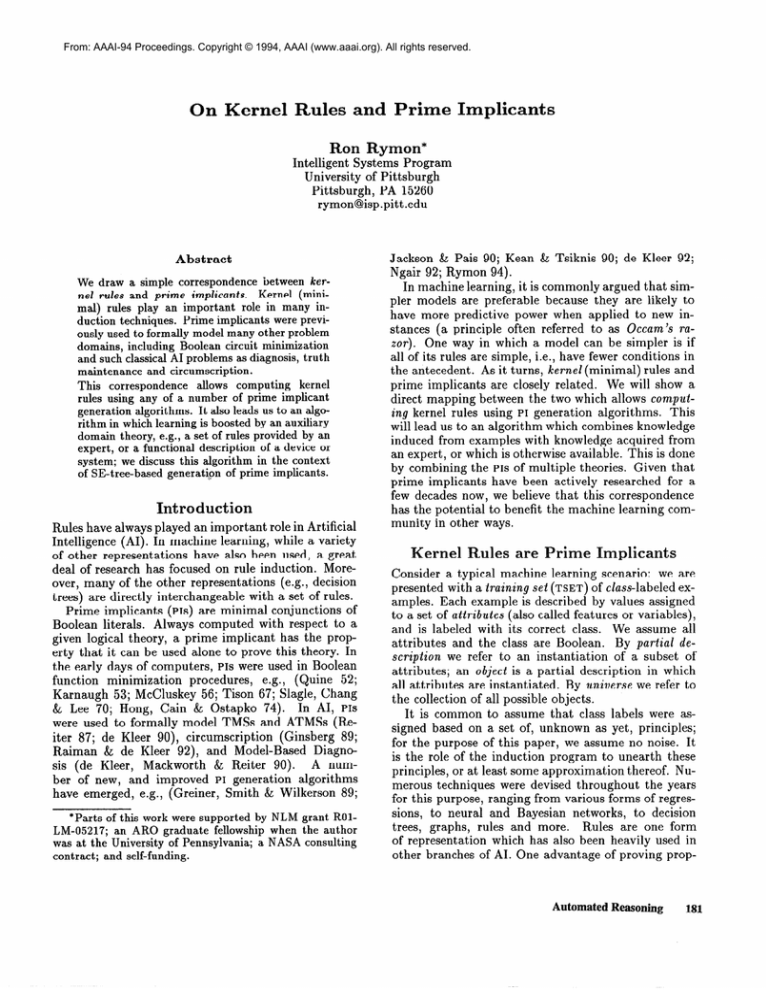
From: AAAI-94 Proceedings. Copyright © 1994, AAAI (www.aaai.org). All rights reserved.
On Kernel
Rules and Prime
Implicants
Ron Rymon*
Intelligent Systems Program
University of Pittsburgh
Pittsburgh, PA 15260
rymon@isp .pitt .edu
Abstract
We draw a simple correspondence
between kernel rules and prime s’mphznts.
Kernel (minimal) rules play an important
role in many induction techniques.
Prime implicants were previously used to formally model many other problem
domains, including Boolean circuit minimization
and such classical AI problems as diagnosis, truth
maintenance
and circumscription.
This correspondence
allows computing
kernel
rules using any of a number of prime implicant
generation algorithms.
It also leads us to an algorithm in which learning is boosted by an auxiliary
domain theory, e.g., a set of rules provided by an
expert, or a functional description
of a device or
system; we discuss this algorithm
in the context
of SE-tree-based
generation
of prime implicants.
Introduction
Rules have always played an important role in Artificial
Intelligence (AI). In machine learning, while a variety
of other representations have also been used, a great
deal of research has focused on rule induction. Moreover, many of the other representations (e.g., decision
trees) are directly interchangeable with a set of rules.
Prime implicants (PIs) are minimal conjunctions of
Boolean literals. Always computed with respect to a
given logical theory, a prime implicant has the property that it can be used alone to prove this theory. In
the early days of computers, PIS were used in Boolean
function minimization procedures, e.g., (Quine 52;
Karnaugh 53; McCluskey 56; Tison 67; Slagle, Chang
& Lee 70; Hong, Cain & Ostapko 74). In AI, PIS
were used to formally model TMSs and ATMSs (Reiter 87; de Kleer 90), circumscription (Ginsberg 89;
Raiman & de Kleer 92), and Model-Based Diagnosis (de Kleer, Mackworth & Reiter 90).
A number of new, and improved PI generation algorithms
have emerged, e.g., (Greiner, Smith & Wilkerson 89;
*Parts of this work were supported
by NLM grant ROlLM-05217;
an AR0 graduate
fellowship when the author
was at the University of Pennsylvania;
a NASA consulting
contract; and self-funding.
Jackson & Pais 90; Kean & Tsiknis 90; de Kleer 92;
Ngair 92; Rymon 94).
In machine learning, it is commonly argued that simpler models are preferable because they are likely to
have more predictive power when applied to new instances (a principle often referred to as Occam’s ruzor). One way in which a model can be simpler is if
all of its rules are simple, i.e., have fewer conditions in
the antecedent. As it turns, kernel (minimal) rules and
prime implicants are closely related. We will show a
direct mapping between the two which allows computing kernel rules using PI generation algorithms. This
will lead us to an algorithm which combines knowledge
induced from examples with knowledge acquired from
an expert, or which is otherwise available. This is done
by combining the PIS of multiple theories. Given that
prime implicants have been actively researched for a
few decades now, we believe that this correspondence
has the potential to benefit the machine learning community in other ways.
ernel
ules are Prime Implicants
Consider a typical machine learning scenario: we are
presented with a training set (TSET) of class-labeled examples. Each example is described by values assigned
to a set of attributes (also called features or variables),
and is labeled with its correct class. We assume all
attributes and the class are Boolean. By partial description we refer to an instantiation of a subset of
attributes; an object is a partial description in which
all attributes are instantiated. By universe we refer to
the collection of all possible objects.
It is common to assume that class labels were assigned based on a set of, unknown as yet, principles;
for the purpose of this paper, we assume no noise. It
is the role of the induction program to unearth these
principles, or at least some approximation thereof. Numerous techniques were devised throughout the years
for this purpose, ranging from various forms of regressions, to neural and Bayesian networks, to decision
trees, graphs, rules and more. Rules are one form
of representation which has also been heavily used in
other branches of AI. One advantage of proving prop-
Automated Reasoning
181
erties for a rule-based representation is that rules are
easily mapped into many of the other representations.
In decision trees, for example, a rule corresponds to
attribute-value assignments labeling a path from the
root to a leaf.
implicants from the corresponding CNF formula, and
vice versa. Many PI generation algorithms assume the
theory is given in one form or the other.
Definition
1 Kernel Rules
A ruZe is a partial description such that all objects in
instantiations in e. Let x be an instantiation of the
class variable. We define
that agree with its instantiated variables are all
labeled with the same class and such that there exists
at least one such object. A kernel rule is a rule such
that none of its subsets is a rule.
Definition 4 Training Set Theory
Let e be an object, and let ai denote
the attribute
TSET
A rule is thus a set’of instantiated variables, and a
kernel rule is one which is set-wise minimal. (To save
notation, we will sometimes refer to this set with the
class variable; the distinction should be clear from the
context.) Another way to view a rule is as a conjunctive set of conditions. We call it a rule because if the
training data were representative of the universe, we
could use it to predict the class of new instances. The
more conditions are included in its conjunction, the
more specific the rule is; a kernel rule is thus a most
general rule.
Kernel rules are the essence of our SE-tree-based
induction framework (Rymon 93). Each kernel rule
corresponds to the attribute-value assignments labeling one path from the root to a leaf. We have shown
that SEtrees generalize, and often outperform, decision trees as classifiers.
Consider the following training examExample
2
ples consisting of various test results (a, b, c, and d) of
patients suspected of suffering from a disease (2):
Patient
a
b
c
d
Disease (2)
1
2
true
false
true
false
true
false
true
false
3
true
false
false
false
true
false
true
The five kernel rules inferable from these examples and
their SE-tree representation are depicted next:
class:z
a-4x
class:Z
ii*z
class:x
b+x
class: 2
class:x
C--rX
d+x
Definition
3 Prime Implicunts (Implicates)
Let V be a set of Boolean variables. A literal is
either a variable v, or its negation iv.
Let C be a
propositional theory. A conjunction of literals R is an
implicunt of C if R + C (where b is the entailment
operator). A disjunction of literals r is an implicate
of C if C + r.
also be thought
Such a conjunction
(disjunction)
can
of as a set of literals.
It is a prime
implicant (implicate) if none of its subsets is an implicant (implicate).
An implicant (implicate) is trivial if
it contains a complementary pair of literals.
Prime implicates and prime implicants are duals. In
particular, any algorithm which computes prime implicates from a DNF formula can also compute prime
182
Automated Reasoning
Let TSET be a set of objects {ej}j”,l,
each labeled
with a class xj. The theory given by TSET is defined:
C(TSET)
dZf AT=1
o(ej,xj)
The purpose of this transformation is to represent
logically the information contributed by a each example alone and by the collection as a whole. For the first
patient
in Example
2 we have:
= SiVbVEVdVx
aAbAcAd+x
As a conjunction, the training set theory can be used
to constrain
the classifiers considered
to those who pro-
duce the same class labels for the given examples.
Theorem
5 Kernel
Rules are Prime
Implicants
Let TSET be a training set, x the class variable. Let
TSET+
be the set of positive examples, and TSET- the
set of negative examples. Let C+ denote C(TSET+)
and
similarly let C- denote C(TSET-).
Let KR+ be the set
of positive kernel rules, i.e., with x in their consequent,
and KR- the set of negative kernel rules, i.e., with z
in their consequent. Let PI(T) denote the collection of
non-trivial PIS for a theory T. Then
KR-=PI(C+)-{
KR+=PI(C-)-(Z)
x } modulo subsumption’ with PI@-);
modulo
subsumption
with PI@+).
Let r be a partial description.
First, it is
clear that x (respectively Z) is a PI for C+ (respectively C-)2. We will prove that (1) if r ELI
and
P # x then either r EKR- or r is subsumed by some
r’ EPI(C-), and (2) vice versa, i.e., if r EKRthen
r ELI.
The proof for the other part of the theorem is analogous.
Proof:
(1) Suppose r EPI(C+) and that T is not subsumed by
any PI of C-. As a PI, r + C+ and thus contradicts
at least one variable assignment in every positive example, and so covers none of these. We still have to
show that there is a negative example that is covered
by r and that r is minimal.
‘One rule subsumes another if it is a subset of the other.
This operation removes from one set a.ll rules subsumed by
any rule from the other set. Note that if a PI appears in
both sets, it is removed from both.
2Also note that x does not appear in any other PI for
TSET+. In fact, to make things computationally easier, x
and f can be omitted from the respective theories; they
were only included for pedagogical reasons to emphasize
the correspondence between clauses and examples.
Suppose that none of the negative examples is covered by T. Since every example assigns a value to
each variable, it must be the case that r contradicts every negative example by at least one variableassignment. Thus, P is an implicant of C- and therefore there is a prime implicant in PI@-)
which subsumes Y. In contradiction to the assumption.
As a prime implicant, r must be minimal and therefore it is a kernel rule.
r EKR-. Then P does not cover any of the
positive examples, and therefore it must contradict
at least one variable assignment in each and every
positive example. Thus, by definition, T is an implicant of C +. As a kernel rule, T is minimal and
therefore it is a prime implicant. Izi
(2) Suppose
Consider again Example 2:
c+ def (iiVbVEVdVx)
A(;iiVbVcVdVx),
and
so PI@+)={x,
8, bc, bd, SC,bd, cd, cd}. Computed simx,
ilarly PI@-)={
- a, b, c, d}: Six of the former PIS are
subsumed by some of the latter, leaving as a negative
kernel rule only ii. All the PIS for C-, except for Z
which is removed, are positive kernel rules.
The first immediate application of Theorem 5 is that
kernel rules can be computed using any of a number
of PI generation algorithms. We briefly explore this
possibility next. This theorem also leads to an opportunity to combine kernel rules with other available
knowledge. As PIS, kernel rules can be combined with
PIS of another theory, e.g., an auxiliary domain theory, to obtain a more refined classifier. We discuss this
possibility in the subsequent sections of this paper. Besides these two immediate applications, we believe this
correspondence may lead to new insights drawn from
one area of research to the other.
Computing
Rules as
rime Implicants
Assuming the availability of a PI generation algorithm,
Theorem 5 suggests a very simple way to compute kernel rules: transform the training set into positive and
negative theories; then compute the PIS for each of the
theories; then, after removing the trivial x and 5, take
the union of the two sets while removing subsumed
conjuncts. The consequent of each rule is determined
by the set from which it came: x in rules originating
from PI( C- ) and Z in those from PI@+).
As previously mentioned, research over the years has
produced an abundance of PI generation algorithms.
Since there may sometimes be an exponential number of PIS, there are also many algorithms which compute subsets of these, or which compute them according to some prioritization scheme. In machine learning,
(Hong 93) used a logic minimization algorithm (Hong,
Cain & Ostapko 74) to induce a minimally covering
set of minimal rules. Each iteration in the STAR algorithm (Michalski 83) essentially computes the PIS of all
negative examples and one positive example. A version
space’s most general rules (Mitchell 82) correspond to
the positive kernel rules, or the PIS of the negative theory. (Ngair 92) shows that both a version space and
PIS are modelable as general order-theoretic structures
and are thus computable using simple lattice operations. The SE-tree-based learning framework (Rymon
93) and PI generation algorithm (Rymon 94) both support partial exploration of rules, e.g., minimal covers
or maximizers of some user-specified priority.
Most of the PI generation algorithms assume that the
input theory is given in either CNF or DNF. For the
purpose of computing the PIS of a training set theory,
a PI generation algorithm should be able to receive its
input in CNF. However, as will soon be discussed, one
may wish to combine these with the PIS of another theory which may be given in a different form; hence the
flexibility offered by the variety of algorithms. Furthermore, certain algorithms may outperform or underperform others, depending on certain features of the
underlying theory and of its PIS.
The flexibility offered by the fact that positive and
negative kernel rules can be computed separately and
then combined using a simple union-with-subsumption
operator may be of practical importance when dealing
with large problems. The disadvantage of this is that
many PIS may later be subsumed; a similar consideration applies when combining PIS of the training set
theory with those of an auxiliary theory. Some of this
duplicity can be avoided in an SE-tree-based framework, as will be discussed later.
oosting
ing with an
ain Theory
uxiliary
One major problem in applying machine learning is
that examples are often scarce. Even where examples
are seemingly abundant, their number is often minuscule relative to the syntactic size of the domain. Learning programs thus face a hard bias selection problem,
having to decide between a large number of distinct
classifiers that equally fit the training set. We propose
that the PI-based approach lends itself to use of auxiliary domain knowledge, in the form of a logical theory,
to leverage learning by restricting the set of hypotheses
considered. Computationally, at least if an SE-treebased algorithm is used, significant parts of the search
space may be discarded without even being searched.
Consider Example 2 again. Since the universe size is
16 (24), and since only three examples were given, there
are 216-3zz212 d’
1ff erent classifiers consistent with the
training examples. Prime implicants belong to a somewhat stricter class, namely conjunctions which entail
the training set theory. While each of the kernel rules
is consistent with the examples, they may contradict
on other objects. Indeed, in the SE-tree-based classification framework, the number of classifiers potentially
embodied in a collection of kernel rules depends on the
number of objects on which two or more rules contradiet. In Example 2, there are 7 such objects (Figure la)
and thus 27 classifiers.
Automated Reasoning
183
Now suppose that in addition to the training examples, we are also given an auxiliary domain theory
(ADT) which we will assume holds in the domain and
thus consistent with the examples. It is reasonable to
demand that labels assigned by a candidate classifier
be consistent with this theory. Furthermore, we will
insist that the classifier entails ADT. To achieve this,
we will compute rules as PIS of the conjunction of the
respective training set theory and ADT.
theories, by invoking same program again. If ADT’ is
also in a CNF then the PISof the combined theories can
be computed in a single shot. Most notably, a set of
rules such as the ones typically gathered from domain
experts can easily be transformed into a CNF.
Consider Example 2 once again. Suppose that in
our domain it is impossible for test (attribute) b to
be positive if test a is negative, i.e., si + 6. We first
transform this statement to a domain theory in CNF:
Theorem
ADT = ADT’ sf (a V b). Then, we compute PIS for
C+UADT,
and similarly for C-UADT. After removing
subsumed PIS, only two rules are left: a a x, and iib a
Z. Figure lb depicts a class-labeled universe according
to these two rules. Notably, there are no contradictions
left (although this does not hold in general). Also note
that part of the syntactic universe that was covered by
the previous set of rules is not covered by the new rules;
according to the ADT, these object are not part of the
real universe as it is impossible for a to be negative
without b being negative as well.
6 Rules for Examples
+ ADT
Let TSET be a training set, x a class variable, and
C+ and C- as before. Let ADT be an auxiliary domain
theory such that ADT def ADTOUADT-UADT+
where
does not mention x nor Z; ADT- is in CNF and
does not mention x; and ADT+ is in CNF and does
ADTO
not mention Z. Let PI+ def PI(C+UADT~UADT+)
and
PI- d!f PI(C-UADTOUADT-).
If T is a partial description then
(1) if r E(PI- modulo subsumption with PI+) then r
does not cover any negative example and does cover
at least one positive example; r is minimal as such.
(2) if T E(PI+ modulo subsumption with PI-) then T
does not cover any positive example and does cover
at least one negative example; T is minimal as such.
We will only prove (1); the proof for (2) is
analogous. If r EPI- then r contradicts at least one
assignment in each of the negative examples; thus it
does not cover any negative example. If T did not cover
any positive example, then Y b C+ and therefore there
exists r’ EPI+ such that r’ E r, in contradiction to the
assumption. p9.E.D
Note that the decomposition of ADT was not used
in the proof. The theorem still holds if ADT is taken
as a whole and PIS for C%ADT,
modulo subsumption,
are taken as negative rules and vice versa for positive
rules. The problem is that important rules may be lost
that way. In particular, consider a situation in which
C- was included as part of ADT. Then, PI(C+UADT)
is subsumed by PI(FUADT)
and we lose all negative
rules.
The new ADT-boosted induction algorithm will thus
partition ADT as above, and then use the respective
components to compute positive and negative rules.
Compared to its predecessor, the new algorithm will
typically result in rules with a more restricted scope.
Note that some new PIS may appear which are independent of the class labeling decision, e.g., a domain
rule such as “males can never be pregnant”. However,
these will appear in both the positive and negative PIS
and will thus be removed by subsumption.
Thanks to the diversity of PI generation algorithms,
ADTO can be given in a variety of syntactic forms; if
it is in DNF, its PIS can be computed separately using
an algorithm which accepts DNF input. The PIS of the
combined theories can then be computed as the PIS of
the combination of the PIS of each of the respective
Proof:
184
Automated Reasoning
def
ub
x
ub
x
iib
xii?
a6
xz
cd
(a) TSET only
Figure‘l:
ub
x
~7;
x
ab
iib
z
cd
(b) with ADT
Class Labelings with and without ADT
Kernel rules can be computed in various orders:
Compute
separately for each of C+UADT+,
and ADTO; then merge while subsuming
supersets. In this case, PI(ADT’) is only computed
once. Using the SE-tree data structure, merging is
linear in the size of the trees. This may be wasteful,
however, if many PIS for one theory are subsumed by
another.
PIS
C-UADT-,
Compute PIS for the two combined theories directly.
This may save time and space if many PIS of ADT’
are later subsumed. However, in essence, many of
the PIS of ADT’ are computed twice.
If the SE-tree method is used, compute PI(ADT’),
and then use the resulting SE-tree as the basis for
search for the PIS of the combined theories. In expanding this tree, nodes previously pruned shall remain pruned. However, unexplored branches may
have to be “re-opened”.
Some of the PIS of ADTO
may have to be further expanded.
An SE-tree-based
Implementation
Set-Enumeration (SE) trees were proposed in (Rymon
92) as a simple way to systematically search a space
of sets. It was suggested they can serve as a uniform
model for many problems in which solutions are modeled as unordered sets.
Given a set of attributes, a complete SE-tree is a
tree representation of all sets of attribute-value pairs.
It uses an indexing on the set of attributes to do so
systematically, i.e., to uniquely represent all such sets.
The SE-tree’s root is always labeled with the empty
set. Then, a node’s descendants are each labeled with
an expansion of the parent’s set with a single attributevalue assignment. The key to systematicity is that a
node is only expanded with attributes ranked higher
in the appropriate indexing scheme than attributes appearing in its own label. For example, assuming alphabetic indexing, a node labeled ubd will not be expanded
with c nor with C, but only with e, f, etc. Allowed attributes are referred to as that node’s View. Of course,
the complete SE-tree is too large to be completely explored and so an algorithm’s search will typically be
restricted to its most relevant parts. A simple PI generation algorithm is outlined in (Rymon 92) as an example application of SE-trees.
In (Rymon 93), we presented an SE-tree-based induction framework
and have argued that it generalizes decision trees in several ways. Like decision trees,
an SE-tree is induced via recursive partitioning of the
training data. Also like decision trees, classification requires traversing matching paths in the tree. However,
an SE-tree embodies many decision trees and thus allows for explicit mediation of conflicts. While here we
assume a fixed indexing, attributes in a node’s View
can be dynamically re-ordered, e.g. by informationgain, without infringing on completeness.
An improved version of the SE-tree-based PI generation algorithm is detailed in (Rymon 94). This algorithm accepts input in CNF and works by computing
minimal hitting sets for the collection of clauses. It is
briefly presented next:
First, given a collection of sets, a hitting set is a set
which “hits” (shares at least one element with) each set
in the collection. Non-trivial PIS correspond to minimal hitting sets (excluding those which include both a
variable and its negation.).
The algorithm works by exploring an imaginary SEtree in a best-first fashion, where PIS are explored in an
order conforming to some user-specified prioritization;
thus, if time constraints are imposed, the most important PIS will be discovered. Exploration starts with
the empty set. Then, iteratively, an open nodes with
the highest priority is expanded with all possible oneattribute expansions which (a) are in that node’s View,
and (b) hit a set not previously hit by that node. Expanded nodes which hit all sets are marked as hitting
sets and the rest remain open for further expansion.
The algorithm uses two pruning rules. First, nodes
subsumed by previously discovered hitting sets can be
pruned; they cannot lead to minimal hitting sets. Second, a node is pruned if any of the sets it does not
hit is completely outside its View; given the SE-tree
structure, such a node cannot lead to a hitting set.
(Rymon 94) also suggests a recursive problem de-
composition heuristic in which the collection of sets
not hit by a node is partitioned into variable-disjoint
sub-collections. If such partitioning exists, the minimal
hitting sets for the union are given by the product of
the minimal hitting sets for the sub-collections. These
are computed via recursive application of the algorithm
to each of the sub-collections.
C-onsider Example 2 again: C+ consists of the sets
{a, b, C,d, x}, (8 b, c d x}
Figures 2a,b depicts the
SE-trees explored fok lomputing PI@+)
and PI@-),
ignoring PIS with x or 5. Note that, in the former, a
branch labeled a was never considered because a does
not appear in C+ and that a branch labeled d was
nruned because it cannot lead to a solution. However.
except for nodes labeled with d or d, other nodes can:
not be pruned for having too narrow a View; this is
because- examples assign-values to all variables. For
the same reason, decomposition is also impossible
-
U
b
b
U
c
w w-1
(c)
PI(ADT)
Figure 2: Original SE-trees
Consider now the ADT def (a V b), as discussed before. Figure 2c shows the SE-tree for PI(ADT).
Figures 3a,b shows SE-trees for the combined theories.
Note that now, branches from the root labeled with c
or C can be pruned because they cannot lead to hitting sets for ADT. Also, once all sets in the training
set-theories are hit, one can take advantage of the decomposition heuristic. Notably, PIS for the combined
theories are more complex; they have to hit more sets.
This makes the resulting rules less conflicting. Figure 3c shows the kernel rules obtained by mergingwith-subsumption the trees in 3a,b.
Summary
We have shown a simple correspondence between kernel rules and prime implicants which
a. Allows computing kernel rules using any of a number
of prime implicants generation algorithms; and
b. Leads to a PI-based learning algorithm which can be
boosted with an auxiliary domain theory, e.g., a set
of rules provided by a domain expert, or a functional
description of a device.
Automated Reasoning
185
b
bc
bd
Hong, S. J., Cain, R. G., and Ostapko, D. L., MINI:
A Heuristic Approach for Logic Minimization. IBM
Journal of Research and Development,
pp. 443-458,
1974.
Hong, S. J., R-MINI: A Heuristic Algorithm for Generating Minimal Rules from Examples. IBM Research
Report RC 19145, 1993.
Jackson, P., and Pais, J., Computing Prime Implicants. In Proceedings Conf. on Automated Deduction,
pp. 543-557, 1990.
(a)
U
b
U
-A
bc
PI(C+UADT)
class: 2
Karnaugh, G., The Map Method for Synthesis of
Combinational Logic Circuits. AIEE Trans. Communications and Electronics, vol. 72, pp. 593-599, 1953.
a
I-
7ib
bd
(c) kernel rules
(b) PI@-UADT)
Figure 3: SE-trees for combined theories
We outline an SE-tree-based algorithm which allows
exploring rules according to some user-defined preference criterion. We hope the domain theory enhancement will eventually contribute to the applicability of
this machine learning approach to real-world domains.
In addition, given the significant research involving
prime implicants, we believe the correspondence presented here may lead to new insights as researchers
reinterpret these results in the realm of machine learning.
Acknowledgement
Discussions with Dr. John Clarke have motivated this
work. I also thank Ron Kohavi, Foster Provost, Bob
Schrag and anonymous reviewers for important discussions and comments.
References
de Kleer, J., Exploiting Locality in a TMS. In Proceedings 8th National Conf. on Artificial Intelligence,
pp. 254-271, Boston MA, 1990.
de Kleer, J., Mackworth, A. K., and Reiter, R., Characterizing Diagnoses. In Proceedings 8th National
Conf. on Artificial Intelligence,
pp. 324-330, Boston
MA, 1990.
de Kleer, J . , An Improved Incremental Algorithm
for Generating Prime Implicates. In Proceedings 10th
National Conf. on Artificial Intelligence, pp. 780-785,
San Jose CA, 1992.
Ginsberg,
Artificial
M., A Circumscriptive Theorem Prover,
39, pp. 209-230, 1989.
Intelligence,
Greiner, R., Smith, B. A., and Wilkerson R. W., A
Correction to the Algorithm in Reiter’s Theory of Diagnosis. Artificial Intelligence, 41, pp. 79-88, 1989.
186
Automated Reasoning
Kean, A., and Tsiknis, G., An Incremental Method
Journal
for Generating Prime implicants/Implicates.
of Symbolic Computation,
9:185-206, 1990.
McCluskey, E., Minimization of Boolean Functions.
Bell System Technical Journal, 35:1417-1444, 1956.
Michalski, R., A Theory and Methodology of Inductive Learning. Artificial Intelligence,
20, 1983, pp.
111-116
Mitchell, T. M., Generalization as Search. Artificial
Intelligence,
18, 1982, pp. 203-226.
Ngair, T., Convex Spaces us an Order-Theoretic
Basis
for Problem Solving, Ph. D. Thesis, Computer and
Information Science, Univ. of Pennsylvania, 1992.
Quine, J. 0. W., The Problem of Simplifying Truth
Functions. American
Math.
Monthly,
59:521-531,
1952.
Raiman, O., and de Kleer, J., A Minimality Maintenance System. In Proceedings 3rd Int’Z Conf. on
Principles of Knowledge Representation
and Reusoning, Cambridge MA, pp. 532-538, 1992.
Reiter, R., A Theory of Diagnosis From First Principles. Artificial Intelligence, 32, pp. 57-95, 1987.
Rymon, R., Search through Systematic Set Enumeration. In Proceedings 3rd Int ‘I Conf. on Principles
of Knowledge
Representation
and Reasoning,
Cambridge MA, pp. 539-550, 1992.
Rymon, R., An SE-tree-based Characterization of the
Induction Problem. In Proceedings 10th Int’l Conf.
pp. 268-275, Amherst MA,
on Machine
Learning,
1993.
Rymon, R., An SE-tree-based Prime Implicant Generation Algorithm. To appear in Annals of Math. and
A.I., special issue on Model-Based Diagnosis, Console
& Friedrich eds., Vol. 11, 1994.
Slagle, J. R., Chang, C, and Lee R. C., A New Algorithm for Generating Prime Implicants. IEEE Trans.
on Computers,
19(4), 1970.
Tison, P., Generalized Consensus Theory and Application to the Minimization of Boolean Functions.
IEEE Trans. on Computers,
16(4):446-456, 1967.

